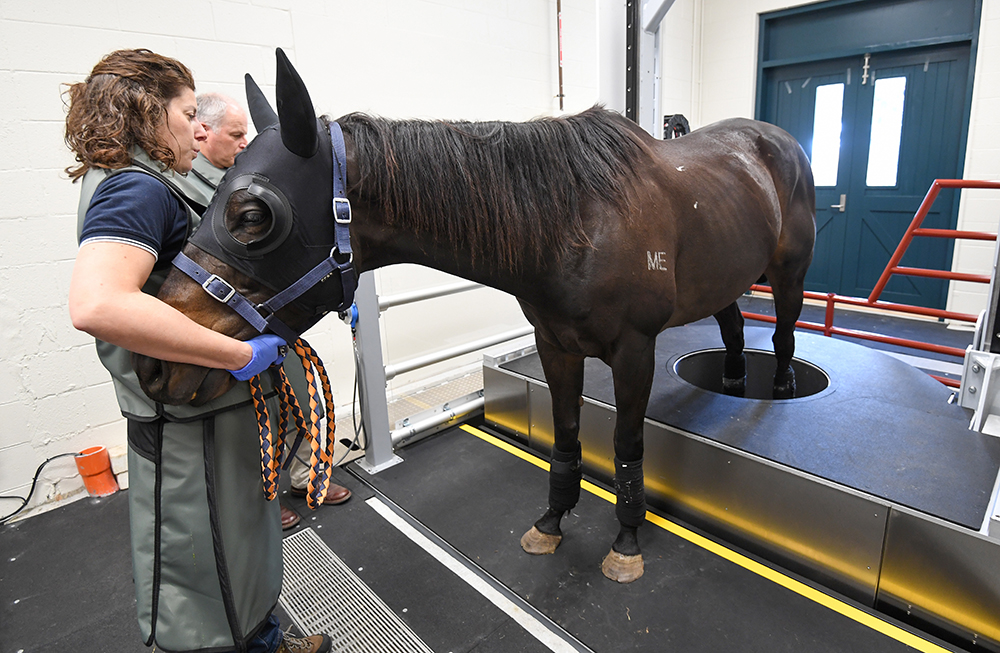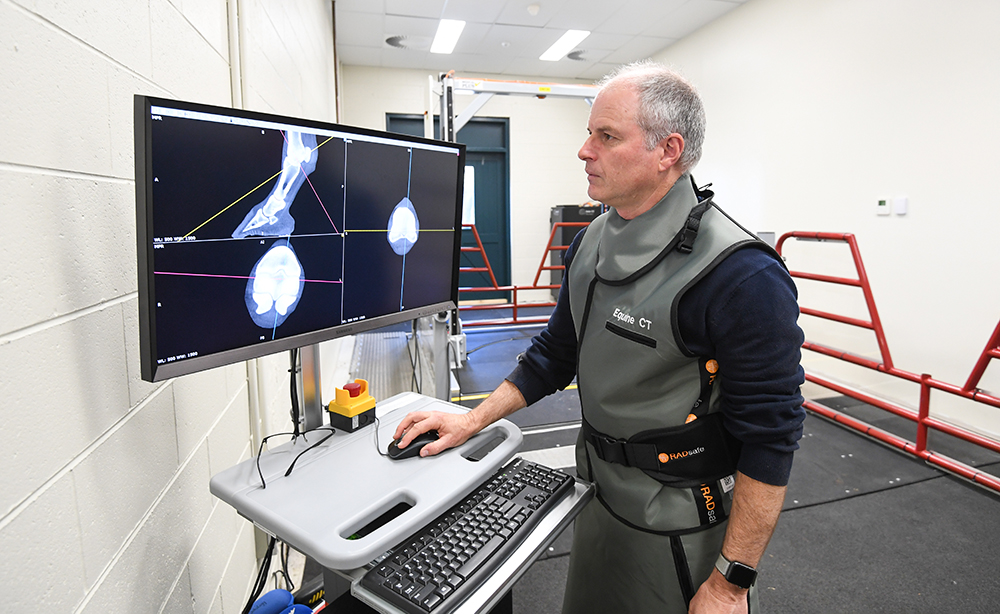Universal health care schemes such as Australia’s Medicare system exist to provide people with low-cost medical help in their hour of need. What if such a scheme existed for horses?

Launched in July 2021, Racing Victoria’s Diagnostic Imaging Subsidy Program has been described as “Medicare for horses” for good reason; it allows the owners and trainers of injured thoroughbreds to offset the cost of advanced diagnostic imaging including scintigraphy, MRI and CT scans. While the program is primarily intended to reduce the financial hurdle owners and trainers may face when dealing with advanced diagnosis of a horse in race training, there’s no doubt that the support injured racehorses receive via this scheme will boost their opportunities for a successful second career off the track.
Promoting the safety and welfare of racehorses at all points in their lives – before, during and after their time on the track – is an overarching aim of Racing Victoria’s Equine Welfare Strategy. The Diagnostic Imaging Subsidy Program aims to minimise the risk of serious injury using early detection and intervention, with the goal of reducing the frequency and severity of acute and chronic injuries.
A FOCUS ON PREVENTION
The Diagnostic Imaging Subsidy Program is not Racing Victoria’s first foray into the importance of diagnostic imaging; since mid-2016, they have supported the Equine Limb Injury Prevention Program, an initiative run by Professor Chris Whitton out of U-Vet Werribee Equine Centre. Professor Whitton has long been involved in research surrounding limb injury prevention in racehorses, studying aspects such as how the horses are trained and the rest intervals they receive impact micro-damage accumulation. Diagnostic imaging — as well as the use of inertial sensors — has become the next phase of this research, with the aim being to find ways to identify horses at risk of serious injury ahead of time.
Professor Whitton explains that recent research — although not yet published — has indicated the importance of diagnostic imaging in the prevention of injury: “There is good data showing that most fatal racehorse injuries have pathology at post-mortem examination that was pre-existing.” Therefore, identifying these pathologies in their infancy has the potential to not only prevent serious injury, but also save lives.

BEYOND RACING
Those who own horses know only too well that injuries can and will occur. They also understand that an ounce of prevention is worth more than a pound of cure! When an equine athlete has two careers, such as a thoroughbred that moves from a racing to an equestrian home and typically changes ownership and management along the way, a veterinary history that includes evidence of early intervention, advanced diagnostics and gold star treatment of injuries can enhance that horse’s appeal and suitability as a performance prospect in comparison to one with less clarity surrounding its medical past.
While Racing Victoria’s Diagnostic Imaging Subsidy Program is currently in its initial six-month trial period, it has already served as a source of relief, support and assistance for Victorian trainers, owners and horses alike, including Wangaratta-based Renee Hoysted. Running a small-scale training stable with four horses in work, Renee found the subsidy program to be invaluable when Hellofahottie, an unraced, untrialled 2017 filly in her stable, presented with lameness.
“When our filly pulled up sore after galloping, there was no obvious cause; no swelling or heat or anything like that, she was just simply quite lame,” Renee explains. “After being assessed by our regular vet we were able to apply for the subsidy for further imaging, as it was the kind of lameness that was going to need scintigraphy, or bone scans, in order to determine what exactly was wrong.”
A lameness examination conducted by a regular veterinarian, or a Racing Victoria raceday veterinarian if lameness presents at the track, is a necessary step for trainers and owners to undertake as part of their eligibility for the subsidy program. If lameness is confirmed, further analysis of the lameness examination results and horse history will be conducted by the veterinarian to identify and recommend whether advanced imaging is required – and if so – which type.
Upon referral by the horse’s veterinarian to one of the three practices participating in Racing Victoria’s program – U-Vet Werribee Equine Centre, Ballarat Veterinary Practice Equine Clinic and Goulburn Valley Equine Hospital – the horse’s owner or trainer is eligible for a specialist assessment subsidy of up to $300, to help cover the cost of additional analysis. Following this further analysis, the owner or trainer of any horse that is accepted into the Diagnostic Imaging Subsidy Program is able to recoup up to 50% of the cost of scintigraphy (bone scanning), magnetic resonance imaging (MRI) or computed tomography (CT), a potential saving of up to $1,600.
“We went through that process and ended up at Ballarat Veterinary Practice Equine Clinic for scintigraphy,” Renee explains. “They found a hot spot in the hock itself, then through further X-rays of the hock they determined that there was a greenstick fracture of one of the small bones that make up the hock joint.”
As Renee explains, receiving a specific diagnosis of Hellofahottie’s lameness gave her comfort, clarity and confidence about the path forward.
“Previously, if we had a horse in a similar situation, the horse was spelled, going off what our vet thought was the issue. That horse would still end up getting the same amount of time off training as one with a pinpoint-accurate diagnosis, but it’s really helpful to know exactly where and what the problem is. Assuming they do make a full recovery, as a trainer you’re then thinking about what you can do differently to build up more strength in that area once they return to work, or to give the horse more support and ongoing management with its past injury in mind,” Renee explains.
“Without the assistance Racing Victoria’s subsidy program has provided, advanced diagnostics of this kind just wouldn’t have been an option for us,” Renee adds. “We’re a family-run stable and these are our own horses, they’re not client’s horses, it’s more of a hobby for us. So we don’t really have the finances available for that sort of thing, or for a follow-up later on, we just wouldn’t have been able to justify it. We love our horses and give them the time they need, but we wouldn’t have known exactly what we were working with.”
For Hellofahottie, who is soon to graduate from yard rest to two months of paddock rest, the chances of returning to full race training are bright. She will be reassessed in December to ensure that the fracture has settled and healed before a steady return to race training commences.

Renee is hopeful that Hellofahottie will enjoy a successful career on the track, and is committed to finding a good home for her at the conclusion of her racing career with full transparency about her injury, diagnosis and recovery – as she does with all of the horses that pass through her training stable.
“Generally I will work with them after they’ve finished on the track and take them out and about, hunting or showjumping when events are on,” Renee explains. “Sometimes people have seen them during their race preps or race careers and will say, ‘Oh I like that one, can I have him when he’s finished on the track?’ which is great, but even if no-one’s put their hand up for them before they come off the track, we always make sure that they go to good homes. I’ve also used a Racing Victoria Acknowledged Retrainer once and had a good result.
“I do think that the financial support Racing Victoria are providing owners and trainers with via this new program will not only help thoroughbreds during their racing careers, it will also help their chances of going to a great home afterwards,” Renee comments. “I remember when I was younger, you’d get a horse off the track and hear, for example, that it had done a tendon. You would just tip it out in the paddock for a while; there weren’t often rehab or treatment plan for injuries in those days. It usually meant the end of a horse’s racing career and someone would take them on after a spell knowing that there was a bit of risk and uncertainty about their future soundness. Nowadays as a trainer and an owner, you can give whoever’s taking an off-the-track horse on all of the information about what has happened and what’s been done about it. Then if the horse does have soundness issues later on, their new owner knows what to look for, to see if it is related to the previous injury, and if it’s not they can rule that out as a concern. So people can feel that there’s less risk in taking on a thoroughbred that had an injury during its race career.”
When Racing Victoria launched its $25 million commitment to the welfare of Victorian thoroughbreds in 2019, it was clear that this would have a profound, long-term impact on the lives and livelihoods of thousands of horses. The implementation of practical, outcome-driven initiatives such as the Equine Diagnostic Imaging Subsidy Program is just one example – along with other Racing Victoria initiatives such as the RESET program – of how much the racing industry has achieved in a relatively short time, on its quest to ensure that the welfare of thoroughbreds is paramount at all stages in their lives. EQ
READ MORE ABOUT OFF THE TRACK HORSES:
‘A Thorough Belief in Thoroughbreds’ (Equestrian Life, September, 2021)
‘General Ready To Conquer Again’ (Equestrian Life, June, 2021)
‘Sparks Fly When Cutting Meets Racing’ (Equestrian Life, May, 2021)
‘Percy Makes His Presence Felt’ (Equestrian Life, March, 2021)
‘Maizy Lands On Her Feet In New Role’ (Equestrian Life, January, 2021)
‘Off The Track & On The Right Path’ (Equestrian Life, December 2020)
‘All Eyes On The Prize’ (Equestrian Life, October 2020)
‘Vale Subzero’ (Equestrian Life, September 2020)
‘Beacon of Hope for Brightlight Boy’ (Equestrian Life, August 2020)
‘From Racecourse to Royal Windsor’ (Equestrian Life, June 2020)

